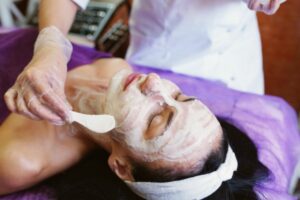“What’s the difference between microdermabrasion and chemical peel?”
“Which one is right for me?”
These are some of the questions people have been asking, and understandably so. With a bunch of skincare treatments to choose from, these two have become very popular, and while there are similarities between them, the best option for you will depend on what skin condition you are trying to heal.
It’s crucial to know and understand these differences, so you make the right choice and reap its benefits.
That being said, this article will help you understand what each procedure does as well as the pros and cons that come with each of them.
What is Microdermabrasion?
Microdermabrasion is a skincare treatment that helps remove dead skin, effectively improving wrinkles and any form of discoloration through the use of a vacuum. It helps promote better skin tone and texture, reduces scars, and makes you look more youthful by fighting signs of aging.
This procedure is considered medical-grade and a form of deep, manual exfoliation which means the dead skin cells are completely removed to reveal a new, much smoother surface.
Microdermabrasion is used to treat a number of skin conditions you can see below:
- Acne
- Clogged pores
- Dry skin
- Minor scars
- Uneven skin pigmentation
The process usually takes around 30 to 40 minutes after which, the dermatologist applies a moisturizer. It is non-invasive, pain-free, and does not require any downtime. More importantly, it is considered safe and effective.
What is a Chemical Peel?
On the other hand, a chemical peel is a procedure that requires at-home, long-term care as you wait for new skin to resurface. Like microdermabrasion, it is also valuable for treating acne, blemishes, fine lines, and wrinkles, among others.
The difference lies in how the outer layer of the epidermis is removed to reveal new skin underneath. Unlike microdermabrasion which uses a suction, a chemical peel is performed using a chemical solution that helps peel the skin away.
Since a chemical peel works deeper on the skin, it’s not surprising how it requires a few days of healing and recovery, which usually lasts for a week (May vary depending on the person).
During this time, you’ll need to refrain from wearing makeup. You may also use ice packs for soothing relief if you feel any discomfort.
It’s also important to keep in mind that results may not be permanent and that you need to ask your dermatologist how often you need to come back for the treatment.
Which one is right for you?
The answer to this question will depend on several considerations and, primarily, what you’re looking to get out of the treatments mentioned.
If what you’re after is a long-term solution, then chemical peel would be the better option, but if you’re looking for something fast and affordable, you’d be better off with microdermabrasion.
If you’re looking to turn back the hands of time, a chemical peel would be much more suitable because it helps exfoliate the skin and promotes collagen production.
Lastly, microdermabrasion is less invasive, which is the better choice for people with sensitive skin. As always, make sure to consult your dermatologist to get the proper recommendation.
Microdermabrasion vs. Chemical Peel for Acne and Acne Scars
Microdermabrasion has the tendency to irritate or make acne worse, making chemical peels a much better option when it comes to acne treatment. On the other hand, microdermabrasion can be the more effective option when it comes to raised acne scar treatment.
But then again, this would depend on the kind of acne scars you’re trying to treat. This is because microdermabrasion only works for certain depressed acne scar types, particularly those that lie against the skin epidermis.
It would be best to talk to your dermatologist for more permanent skin conditions like ice pick scars.
Microdermabrasion vs. Chemical Peel for Wrinkles
When it comes to wrinkle treatment, the choice would depend on the kind of wrinkle you’re trying to address.
For light wrinkles, microdermabrasion should be enough or a light chemical peel, for that matter. On the other hand, deep wrinkles will require a deeper solution, making chemical peel the more suitable option for such.
Can you get Microdermabrasion and Chemical Peel at the same time?
The short but sweet answer is “yes,” you can. In fact, combining both procedures works more effectively for cleaning the skin and reducing blemishes like discoloration and wrinkles, just to name a few.
This combination is also highly-recommended for people with oily skin as well as those who are prone to acne. You can think of microdermabrasion as something similar to mowing the lawn, while a chemical peel is more like aerating it. You can also exfoliate your skin through dermaplaning, a procedure that removes the top layer of skin.
Microdermabrasion and chemical peels are highly effective, but getting them done together will yield far better results.
Final Thoughts
Microdermabrasion and chemical peel are both tried and tested procedures that can help treat various skin conditions. While both come with their respective pros and cons, understanding what’s more suitable for your skin type will go a very long way.
These procedures have proven effective, but it’s still safe to say that prevention will always be better than cure which is why we recommend practicing habits that promote good skin health, which you can learn more about in our new book, Unmasking Acne.

